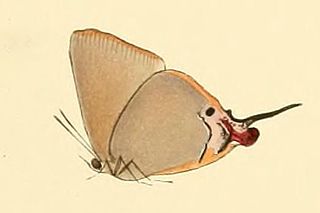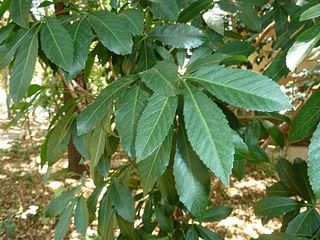NATAL or Natal may refer to:

Azanus ubaldus, the bright babul blue, desert babul blue, or velvet-spotted blue, is a small butterfly found in India, the Middle East and Africa that belongs to the lycaenids or blues family.

The Natal dwarf puddle frog is a species of frog in the family Phrynobatrachidae. It is found in Angola, Benin, Botswana, Burundi, Cameroon, Central African Republic, Republic of the Congo, Democratic Republic of the Congo, Ivory Coast, Eswatini, Eritrea, Ethiopia, Gambia, Ghana, Guinea, Guinea-Bissau, Kenya, Liberia, Malawi, Mali, Mozambique, Namibia, Nigeria, Rwanda, Senegal, Sierra Leone, South Africa, Sudan, Tanzania, Togo, Uganda, Zambia, Zimbabwe, and possibly Burkina Faso, Chad, Lesotho, and Mauritania.
(Orachrysops ariadne), the Karkloof blue, is a species of butterfly in the family Lycaenidae.

Junonia oenone, the blue pansy or dark blue pansy, is a Nymphalid butterfly native to Africa. "Blue pansy" is also used in India to describe Junonia orithya.

Charaxes brutus, the white-barred emperor or white-barred Charaxes, is a butterfly of the family Nymphalidae. It is found in Africa.

The Maputaland-Pondoland-Albany Hotspot (MPA) is a biodiversity hotspot, a biogeographic region with significant levels of biodiversity, in Southern Africa. It is situated near the south-eastern coast of Africa, occupying an area between the Great Escarpment and the Indian Ocean. The area is named after Maputaland, Pondoland and Albany. It stretches from the Albany Centre of Plant Endemism in the Eastern Cape Province of South Africa, through the Pondoland Centre of Plant Endemism and KwaZulu-Natal Province, the eastern side of Eswatini and into southern Mozambique and Mpumalanga. The Maputaland Centre of Plant Endemism is contained in northern KwaZulu-Natal and southern Mozambique.
Abantis paradisea, the paradise skipper, is a butterfly of the family Hesperiidae. It is found in KwaZulu-Natal, Zululand, Transvaal, Eswatini, Zimbabwe and from Botswana to Somalia.

Durbania amakosa, the Amakosa rocksitter, is a butterfly of the family Lycaenidae. It is found in South Africa.

Myrina dermaptera, the lesser fig-tree blue or scarce fig-tree blue, is a butterfly of the family Lycaenidae. It is found in Sub-Saharan Africa, southern Arabia and northern Oman.

Cigaritis natalensis, the Natal bar or Natal barred blue, is a butterfly of the family Lycaenidae. It is found in South Africa, from the Eastern Cape along the coast to KwaZulu-Natal, Eswatini, the Free State, Mpumalanga, Gauteng, Limpopo and North West provinces, and part of the Northern Cape province. It is also present in Botswana.
Chrysoritis natalensis, the Natal opal, is a butterfly of the family Lycaenidae. It is found in South Africa, where it is found from the Eastern Cape, along the coast of KwaZulu-Natal and inland to Zululand and the midlands.

Sevenia natalensis, the Natal tree nymph, is a butterfly in the family Nymphalidae found in southeastern Africa.

Charaxes cithaeron, the blue-spotted emperor or blue-spotted charaxes, is a butterfly of the family Nymphalidae. It is found in south-east Africa.

Azanus moriqua, the black-bordered babul blue or thorn-tree blue, is a butterfly of the family Lycaenidae. It is found in the Afrotropical realm.

Azanus mirza, the pale babul blue or mirza blue, is a butterfly of the family Lycaenidae. It is found in the Afrotropical realm.

Mikania natalensis, the Natal mikania, is a plant in the family Asteraceae, and is native to Africa.

Empisini Nature Reserve was established in 1973 and is situated in Umkomaas, KwaZulu-Natal, South Africa. The reserve is approximately 60 ha in extent and is owned by the borough of uMkhomanzi which has been incorporated into the eThekwini municipality. Empisini is managed jointly by eThekwini and the Umkomaas centre of the Wildlife and Environment Society of South Africa. Empisini takes its name from a perennial stream which flows through it, and means "Place of the Hyena" in isiZulu. The reserve consists of coastal forest, wetlands, grassy slopes and a dam. Infrastructure consists of hiking trails, demarcated picnic sites, overnight cabins, and a tree house.

Allophylus natalensis, commonly known as the dune false crowberry or dune false currant, is a species of plant in the genus Allophylus native to south-eastern Africa.

Thunbergia natalensis is a species of flowering plant in the family Acanthaceae, that is native to parts of mainland Africa, including South Africa, Eswatini, Tanzania, Ethiopia, Malawi and Zimbabwe. It occurs in forest margins, bush and grassland. Normally evergreen, it responds to dry or cold winters by losing its leaves and going dormant. Common names include dwarf thunbergia, Natal blue thunbergia and Natal blue-bell.


















